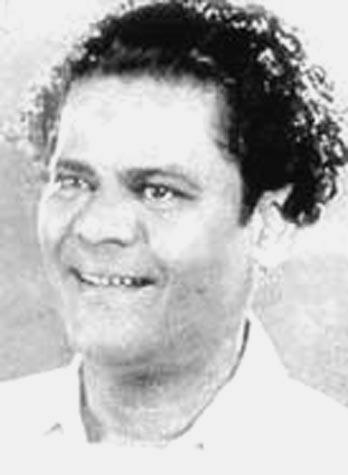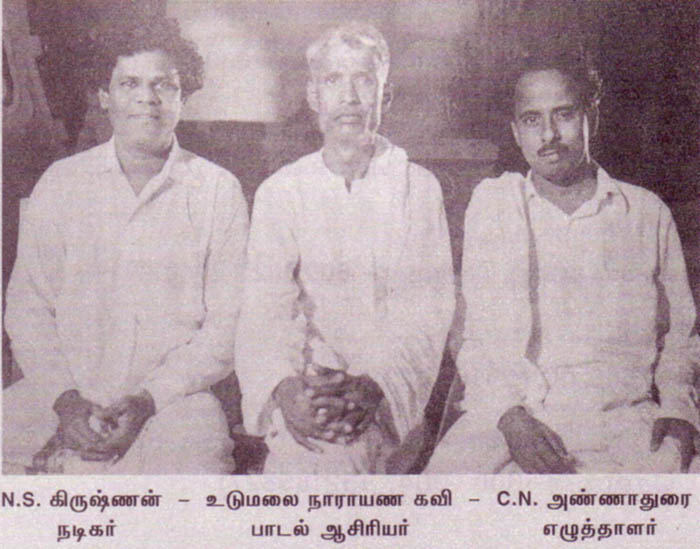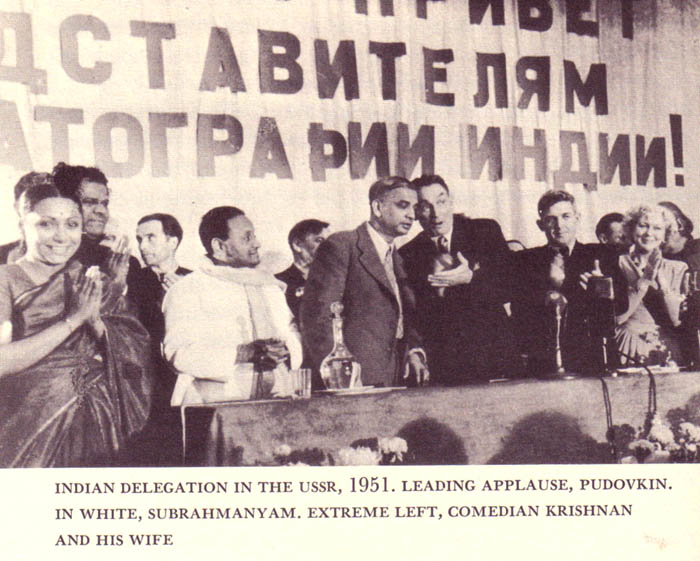|
 A
Birth Centenary Tribute to Kalaivanar N.S. Krishnan, the Tamil Comedian and Political
Activist by Sachi Sri Kantha, 29 November 2008 A
Birth Centenary Tribute to Kalaivanar N.S. Krishnan, the Tamil Comedian and Political
Activist by Sachi Sri Kantha, 29 November 2008
It is
rather unfortunate that scholarship on Tamil comedy
in performing arts (in stage, cinema, radio and TV)
has been shoddy at best. Available information on
Nagarkoyil Sudalaimuthu (N.S.) Krishnan (1908-1957),
the king of Tamil comedy, in the internet has been
insipid and banal. As such, I venture in this essay
to view N.S. Krishnan (hereafter NSK) from a fresh
angle, on his birth centenary falling on November 29,
2008.
In Tamil pulp literature, NSK has been compared
with Charlie Chaplin (1889-1977). That both Chaplin
and NSK had (1) a similar deprived upbringing, (2)
early entrance into the music-hall stage performances
in London and southern Tamil Nadu as primary school
dropouts, and (3) entry into movies from stage comedy
in their mid-20s, had precipitated this analogy of
NSK as a Chaplin clone. The fact that
NSK�s entry as a first-generation
comedian into Tamil cinema [heralded by the release
of Menaka on April 6, 1935] almost overlapped
with Chaplin�s final performance as
the tramp [in the Modern Times was in 1936]
makes it inconvenient for easy comparison between the
two comedians. In the 1930s, NSK�s
fellow cinema comedians had prefix tag names like
Buffoon Sanmugam, Loose Arumugam and Joker
Ramudu.
As of now, I could locate only two recorded
references in English, relating to
NSK�s career in comedy. These are as
follows:
Evaluation of Barnouw and Krishnaswamy
(1963)
�A brilliant comedian and
satirist, he [N.S. Krishnan] was often compared
with Chaplin. His following was confined to the
Tamil-speaking area, but the intensity of its
devotion appears to have matched anything in the
annals of comedy. When he died in 1957, the crowds
at his funeral procession are said to have been
comparable to those at the funeral of Mahatma
Gandhi.
Krishnan had built his huge following during
the war years, when it had become almost obligatory
for a Tamil film to have a Krishnan sequence,
though unrelated to the main plot. Krishnan had
always written such sequences himself, and acted
them with his wife, Mathuram, and other associates.
During the war period over a hundred such sequences
were made by Krishnan for many different producers.
By the beginning of the independence era he was a
figure of towering stature. (Footnote: A trial on a
murder charge, of which he was acquitted, had the
effect of increasing Krishnan�s
popularity. His attorney in the case was the
statesman and man of letters, K.M. Munshi, who
conferred with Krishnan several times
�in the lock up�
and later wrote of these meetings:
�Even under the Damoclean sword
which was hanging over him he would cheerfully
mimic Mr. Justice Mockett, myself and my learned
opponent the Advocate General �
and all with such inimitable grotesqueness as to
throw me into fits of irrepressible laughter. Never
for a moment had I thought of myself as cutting so
ludicrous a figure in a court of
law.�)
In 1948 Krishnan produced a feature film
which Annadurai wrote. As the party began its
organization, Krishnan appeared often at its
rallies and gave enormous impetus to its growth.
The skits he performed on such occasion often
satirized orthodoxy. In some there was ridicule of
Brahmins. Such features were always sure of an
ovation at DMK
rallies.�
I, for one, have difficulty in agreeing that
NSK�s comedy is in the same plank as
that of his illustrious contemporary Charlie Chaplin.
It is like comparing a butterfly with that of a bee.
Though there seems to be some superficial
similarities between NSK and Chaplin, the differences
(see below) outweigh the similarities.
A thumb-sketch by Rajadhyaksha and Willemen
(1999)
The following synopsis on
NSK�s stage and cinema career
appears in the compilation of Rajadhyaksha and
Willemen,
that erroneously identifies the
comedian�s birth year as 1905,
instead of 1908.
�Legendary Tamil film
comedian, stage actor and political activist. Born
in Nagerkoyil, in former Travancore. Joined the TKS
Brothers drama troupe aged 17, replacing the
comedian and film star M.R. Swaminathan (seen in
e.g: 1000 Thalaivangi Apoorva Chintamani,
1947). Was already a noted stage star when debuting
in the TKS Brothers production of Raja
Sandow�s Menaka. Early
films with Sandow (Vasantasena,
Chandrakantha) where he met his wife and
long-term comedy partner T.A. Mathuram (1918-1974).
Played a lead role in Alibababum 40
Thirudargalum, establishing his distinctive
brand of comedy.
Classic screen image developed Kattiyankaran
folk theatre conventions with a separate sub-plot
and spoken dialect as opposed to the high-flown
Elangovan-type language (e.g: playing fishermen
with T.S. Dorairaj in Shakuntalai; Mudal
Thedi). In this style, the comedian can address
the audience directly and allude to topical events
(e.g: his funny song in Paithiakaran,
referring to his jail sentence; his lines in the
costumed period movie Amarakavi referring to
a recent visit to the USSR).
The style is enhanced by the comic but
politically strident lyrics of Udumalai Narayana Kavi,
written specially for Krishnan (e.g:
Nallathamb). Initially a Marxist
sympathizer and a friend of Pa. Jeevanandan (whom
he sheltered when the CP was banned), Krishnan
became first a nationalist and then a DMK
supporter, producing C.N.
Annadurai�s DMK film,
Nallathambi, directing Panam and
acting in the Karunanidhi-scripted Raja Rani
and Rangoon Radha.

Together with M.K.
Thyagaraja Bhagavathar, he was convicted of
murdering the gossip columnist Lakshimikantan
although he proclaimed his innocence all his life.
His wife started the N.S.K. Nataka Sabha (aka
Eneskay Nataka Sabha) staging plays mainly directed
by and featuring the star S.V. Sahasranamam. Their
best-known play is P.
Neelakantan�s nationalistic
Nam Iruvar, later filmed
(1947) by the AVM Studio. The company debuted in
film production with Paithiyakaran; their
best-known productions are Nallathambi and the
Krishnan-directed Manamagal and
Panam. Panam, a major DMK film,
featured the Parasakthi (1952) combination
of writer Karunanidhi and star Ganesan, while
Krishnan sang a pro-DMK song. It also featured
documentary footage of a DMK Party
conference.�
NSK�s other three prominent
DMK associates in Tamil movie world (noted above),
namely lyricist Udumalai Narayana Kavi (1899-1981),
script
writer-politicians Anna (1909-1969), and Karunanidhi
(b.1924) outlived him. Now, I provide comparisons
between Chaplin and NSK brands of comedy.
NSK�s similarities with
Chaplin
(1) Both Chaplin and NSK had Dickensian
childhood and drifted to stage performance because
of it, for survival. What
Chaplin�s biographer Theodore Huff
noted, �a philosophy, teaching the
sweetness of adversity, runs through all the
amusing but penetrating studies of life Chaplin has
given us.� may fit equally well to
NSK.
(2) The politics of Chaplin and NSK was left
of Center, and both reveled in tweaking the noses
of authority figures. While
Chaplin�s most adventurous role of
his career was parodying Hitler in The Great
Dictator (1940), NSK never had an equally
prominent role in his movie career, though he had a
pungent song with suggestive pun
�Theena Muuna
Kaana� propagating the glory of DMK in
the movie Panam (lit. Money, 1952). NSK also
visited the then USSR in 1951.

(3) Both Chaplin and NSK had one of their
wives in films, providing a companion foil. While
Chaplin�s third wife Paulette
Goddard (1910-1990) was a co-star with Chaplin in
Modern Times(1936) and The Great
Dictator(1940), it was unusual for an NSK movie
without his second wife Mathuram accompanying her
husband. It should be noted that before Paulette
Goddard and before his first marriage, in late
1910s, Chaplin worked with his then flame Edna
Purviance (1895-1958) in more than 30
films.
(4) Both Chaplin and NSK had their
entanglements with law enforcement. While Chaplin
received warrants for his divorce trials and
paternity suits but without spending a day behind
the bars, NSK was arrested as an accused in a
murder trial of gossip columnist/ muck-raker
journalist C.N. Lakshimikanthan, and served jail
sentence for nearly 2 years and 2 months (from
Feb.12th 1945 to April 25th
1947).
(5) Both Chaplin and NSK were creative in
establishing their screen mascots. If the lovable
tramp was Chaplin�s alter-ego for
the silent screen, NSK�s creation
for the talkie screen was the kattiyankaran
character, adopted from traditional Tamil stage.
The Tamil word
�kattiyankaran�
has a wider range of meanings; literally a herald,
but expanding into the boundaries of the function
of buffoon, clown, jester and predictor.
NSK�s differences from
Chaplin
(1) Primarily, the major difference of
NSK�s comedy to that of
Chaplin�s comedy was based on the
distinction between silent and talkie movies. While
most of Chaplin�s movies were of
silent varieties, all of NSK�s
movies were talkies. Only the last 5 (from 1940 to
1967) of nearly 81 movies of Chaplin were talkies.
In his 1964 autobiography, Chaplin had
noted:
�Although a good silent
film was more artistic, I had to admit that sound
made characters more present. Occasionally I
mused over the possibility of making a sound
film, but the thought sickened me, for I realized
I could never achieve the excellence of my silent
pictures. It would mean giving up my tramp
character entirely. Some people suggested that
the tramp might talk. This was unthinkable, for
the first word he ever uttered would transform
him into another person. Besides, the matrix out
of which he was born was as mute as the rags he
wore.�
If Chaplin�s speciality in
comedy was visual, slapstick and pantomime,
NSK�s comedy was mostly oral.
Verbal humor filled with pun and repartee, as well
as songs derived from stage folk plays constituted
NSK�s
�matrix�. This
canvas limited NSK�s appeal to
only Tamil-speaking audience. There is disagreement
on the number of NSK�s movies.
Some web sources mention an inflated number of 150
movies. Vamanan (2004) had listed 82 movie titles
as NSK�s output. When
cross-checking with Film News
Ananthan�s (2004) database on
Tamil movies, I counted about 12 omissions. Thus,
altogether, NSK�s movie
productivity cumulates to 94 movie titles, nearly
50 lesser than the over-estimated number of
150.
(2) Secondarily, while Chaplin had a long
life of 88 years; with active involvement in movies
from 1914 to 1967 when he released his final movie
A Countess from Hong Kong at the age of 77,
NSK had a short life span of 48 years, with a movie
career limited to 22 years, of which two (between
Feb 1945 and April 1947) were spent in
imprisonment. During the pre-imprisonment phase of
his career, 55 of NSK�s movies
were released, among which three were his own
productions. The period between April 1947 and his
death on August 1957 saw the release of another 34
of his movies, among which NSK�s
own productions accounted for four movies, namely
Paithiakaran (1947), Nallathambi
(1949), Manamagal (1951) and Panam
(1952). Five more movies of NSK were released
posthumously. Among these five movies, two each
were MGR (Raja Thesingu, 1960;
Arasilankumari, 1961) and Sivaji Ganesan
(Ambikapathi, 1957; Thanga Pathumai,
1959) starrers.
(3) While Chaplin had a good ear for music,
had composed music for all his
�sound films�
since City Lights (1931), and his voice was
first heard in a six-line gibberish song [Se bella
piu satore, je notre so catore �
Je notre qui cavore, je la ku la qui la quai] he
sang in Modern Times, music was hardly a
major component of his comedy. In one of his early
movies, The Vagabond (1916), Chaplin did
play a street musician. NSK, on the other hand, was
a folk-musician in his own right and used songs to
spread his social reform message and enliven his
comedy routine. Usually, he appeared with a
percussion instrument in his characters. Singing
comedians have been rare even in Hollywood. Among
the 22 comedians/comedian pairs/comedian teams
profiled by Lenoard Maltin for his 1978 book The
Great Movie Comedians from Charlie Chaplin to Woody
Allen, only Danny Kaye can be distinguished as
a good singer. Among the Tamil comedians who
followed NSK, only J.P. Chandrababu can be merited
as a good singer.
(4) While Chaplin was not known as a patron
of folk arts, Venkatraman credits NSK as a
rejuvenator and populariser of villu-p-pattu
(bow song), a Tamil folk art form (story telling
with satirical witty songs). NSK�s
pioneering steps were boosted by a few of his movie
proteges (actor S.S. Rajendran, comedian Kuladeivam
Rajagopal, and one of his assistants Subbu
Arumugam).
(5) Healthwise, until he married his fourth
wife Oona in 1944, by all contemporary accounts
Chaplin suffered from a character flow of an
over-sexed Don Juan, bedding nubile teenage
starlets. An entry under the theme
�Women� in The
Chaplin Encyclopedia notes that
�On 11 January 1972, David Lewin
of the Daily Mail quoted his response to the
question, �What is your
weakness?�, �My
weakness?� replied Chaplin,
�Women. I love them
all.�� Because
his father died of alcoholism at the age of 37 and
his step-mother Louise also was an alcoholic,
Chaplin �had an understandable
aversion to alcohol, which had brought such tragedy
to his family�, noted his
biographer Theodore Huff. Opposingly, NSK fell
victim to alcoholism, though he had preached
against this malady in one of his well known songs,
and died of liver disease, aged 48, on Aug. 30,
1957.
A Lesson Learnt in colonial
Ceylon
In late 1970s, I read the memoirs of Tamil
drama pioneer T.K. Shanmugam�s (TKS)
�Enathu Nadaga
Vaazhkai� (My Life in Drama). In
it, Shanmugam reminisced about an incident that had
happened in colonial Ceylon. I then annotated this
incident with the caption, �The
Ceylon Tamil who demanded apology from
Kalaivanar� and this appeared in the
Sudar tamil magazine of May 1980.
Unfortunately, neither I do have a copy of this
print, nor the TKS�s memoir with me
now. Thus from memory, I write the story as
recollected by TKS.
NSK has joined the TKS
Brothers� drama troupe Madurai Sri
Bala Sanmuganantha Sabha at the age of 17. This
probably would have been around 1925. Subsequently,
this drama troupe was invited for a Ceylon tour, as
was usual in those days. The sponsor of this Ceylon
tour was one Shanmugam Pillai. While on stage, NSK
had cracked an off-beat impromptu remark to his pal,
�You play (kiss) with your love
interest, while I kiss with my mother
here.� This remark made Shanmugam
Pillai, the sponsor, so furious that at the end of
the play, he admonished the young NSK;
�Merely to elicit a laugh from the
audience, you never ever crack a joke that goes
against our society mores.�
Flabbergasted NSK then tendered his apologies to
Shanmugam Pillai. The fact that TKS had included this
incident in his memoirs reveals his sincerity and the
code of conduct adopted in stage in those days.
Lately, NSK�s comedy lines in movies
came to be appreciated for their cleanliness,
uninfected by double entendre. It can be inferred
that the admonishment of sponsor Shanmugam Pillai
might have had some influence NSK�s
character.
Coda
In his autobiography, the Tamil Nadu Chief
Minister M. Karunanidhi, was apt and has
graciously compared NSK to Aristophanes (c 450-385 BC), a
contemporary of Socrates (c 427-347 BC) and Plato (c 469-399 BC). Karunanidhi
equated his political mentors Periyar E.V. Ramasamy to
Socrates, and Annadurai to Plato. Though NSK was a
benefactor to young Karunanidhi in the film world,
this comparison of EVR, Anna and NSK is well fitting.
To sum up, it can be noted that
NSK�s song and comedy routines were
so unique that though there has been quite a few
tagged pretenders in the Tamil movie world, none
could rival NSK�s stature. Some may
scream that the situation, tempo and entertainment
milieu have changed. But nothing prevents a comedy
genius to take charge of a situation surrounding him
to generate rib-tickling, thought-provoking comedy.
This was true to the world of Aristophanes and to Chaplin and NSK as
well.
References
Film News Anandan: Sadhanaigal Padaitha
Thamizh Thiraipada Varalaru. Manivasagar
Pathippagam, Madras, 2004.
E. Barnouw and S. Krishnaswamy:
Indian Film. Columbia University Press,
New York, 1963, pp. 173-174.
C. Chaplin:
My
Autobiography. Penguin Books, 1964.
T. Huff: Charlie Chaplin. Pyramid
edition, 1964 (originally published
1951).
Kalaignar Karunanidhi: Nenjukku Neethi
(autobiography), part 1. Thirumagal Nilayam,
Chennai, 1985. 2nd ed., pp. 141-158 and
314-322.
L. Maltin: The Great Movie Comedians from
Charlie Chaplin to Woody Allen. Crown
Publishers, New York, 1978.
G. Mitchell: The Chaplin Encyclopedia.
B.T. Batsford Ltd, London, 1997.
A. Rajadhyaksha and P. Willemen:
Encyclopedia of Indian Cinema D.
Robinson: Charlie Chaplin Comic Genius.
Harry Abrams Inc., New York,
1996. D.
Robinson: Charlie Chaplin Comic Genius.
Harry Abrams Inc., New York,
1996.
Vamanan: Thirai Isai Alaigal. Part
1. Manivasagar Pathippagam, Chennai. 2004 (2nd ed),
pp. 148-159.
S. Venkatraman: Villu-P-Pattu. Indian
Folklife Newsletter, April 2000; 1(1):
15.
|